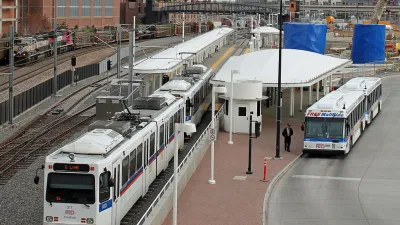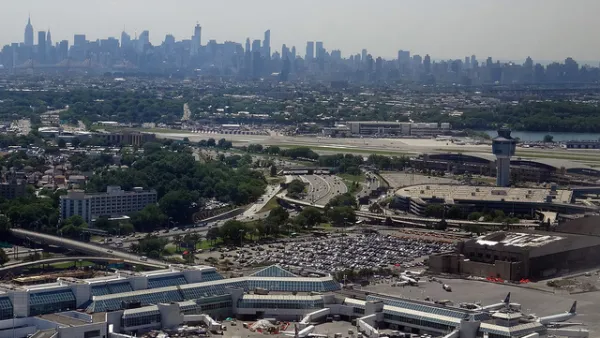Josh Barro provide examples galore of why the answer to that question isn't always yes—where costly rail investment has been to the detriment of existing transit. His column targets proposed projects, such as New York's LaGuardia Airport AirTrain.

"Bus-based public transit in the United States suffers from an image problem," writes Barro. "That fact, laid out in a 2009 report from the Federal Transit Administration, isn’t surprising, but it has led to a perverse outcome."
- Gov. Andrew Cuomo’s proposed AirTrain link from La Guardia Airport in New York could be the latest example. It might cost $450 million or it might be more like $1 billion—the M.T.A. head Tom Pendergrast wavered between the figures in a public hearing last month—but either way, from most places in New York City, it won’t be faster than taking existing bus service to the airport, because it will run southeast from the airport, away from Manhattan
- In California, Bay Area Rapid Transit spent nearly half a billion dollars to build a three-mile rail connector to the airport in Oakland, which opened last year; it saves about 3,000 daily riders four minutes over the shuttle bus service it replaced
Barro is hardly the first to question costly airport connectors—one of the best columns I've seen comes from Market Urbanism in 2010 by Stephen Smith, now editor of New York Yimby. Barro has a larger audience to spread the "rail isn't always better" message.
However, to effectively question rail as always being the best transit investment, it's necessary to point to worthy bus projects. "The Massachusetts Bay Transit Authority has had modest success getting people to ride buses (the "Silver Line") from downtown to the airport; from most points in Boston, that trip also involves a train to the bus to the plane," writes Barro.
Benjamin de la Peña and Nicholas Turner, both formerly with The Rockefeller Foundation's urban development division, penned a July 2013 Planetizen Exclusive that describes other worthy bus projects throughout the United States.
Barro questions streetcar investments in recently opened systems and those still in the planning phase.
- Atlanta’s downtown streetcar loop was a relative bargain at $100 million; unfortunately, Rebecca Burns, a writer at Atlanta magazine, took it to work for a week and found it was slower than walking.
- Washington’s shiny new streetcars, expected to serve 1,500 riders a day along H Street Northeast, are slowing the bus service that already serves 12,000 daily riders on that road. [No opening date scheduled as of Jan. 16].
Barro's main point is that transit agencies need to better market their express and rapid bus lines if they want to increase ridership with choice or discretionary transit riders (those who have access to cars). He points to recent success that Los Angeles Metro has had with the Orange (bus) line that operates on an exclusive right-of-way.
Returning to N.Y. Gov. Andrew Cuomo's proposed LaGuardia AirTrain, Barro suggests that MTA "sell the Q70 and M60 services to people who normally wouldn’t be caught dead on a bus to the airport. Dedicated boarding areas and improved buses could be bought for a fraction of the price of a new train system."
FULL STORY: To Save Money on Building Rail, Spend Money on Marketing Buses

Analysis: Cybertruck Fatality Rate Far Exceeds That of Ford Pinto
The Tesla Cybertruck was recalled seven times last year.

National Parks Layoffs Will Cause Communities to Lose Billions
Thousands of essential park workers were laid off this week, just before the busy spring break season.

Retro-silient?: America’s First “Eco-burb,” The Woodlands Turns 50
A master-planned community north of Houston offers lessons on green infrastructure and resilient design, but falls short of its founder’s lofty affordability and walkability goals.

Test News Post 1
This is a summary

Analysis: Cybertruck Fatality Rate Far Exceeds That of Ford Pinto
The Tesla Cybertruck was recalled seven times last year.

Test News Headline 46
Test for the image on the front page.
Urban Design for Planners 1: Software Tools
This six-course series explores essential urban design concepts using open source software and equips planners with the tools they need to participate fully in the urban design process.
Planning for Universal Design
Learn the tools for implementing Universal Design in planning regulations.
EMC Planning Group, Inc.
Planetizen
Planetizen
Mpact (formerly Rail~Volution)
Great Falls Development Authority, Inc.
HUDs Office of Policy Development and Research
NYU Wagner Graduate School of Public Service


























